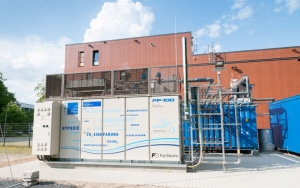Since the end of last May, the Center for Fuel Cell Technology (ZBT) in Duisburg has had a phosphoric acid fuel cell (PAFC) in operation, which supplies the research institute with power and heat. The 100-kW unit even took on three additional tasks: It reduces energy costs, it serves as the basis for scientific studies in combined heat and power and it helps to produce air low on oxygen.
The ZBT had already worked on fuel-cell systems creating air with low oxygen content in 2008, together with the back then start-up N2telligence. At that time, both partners presented their design at the World Hydrogen Energy Conference (WHEC) in Essen, a design that produces power and heat at the same time while also creating air low on oxygen. This air could be used, basically as a side-effect, to simulate heights for training purposes. In the meantime, the initial idea has been turned into a commercial product: QuattroGeneration units have already been supplying electricity, heat, cooling and air low on oxygen at various locations, just as in Duisburg.
The “exhaust gases,” which originate at the cathode in Fuji Electric‘s PAFC unit driven by natural gas, have a lower oxygen content because part of the O2 molecules react with H2 ones, producing power and heat. For example, this exhaust air can be used for medical applications (hypoxia), for inert suppression or even for fire protection. To enable such usage, a second container was installed, about which Professor Dr. Joachim Fandrey from the Institute of Physiology at the University Hospital Essen said that the climate inside corresponded to a height of 2,500 meters above sea level.
The focus of the tests at the institute adjacent to the University of Duisburg-Essen (UDE), however, is combined heat and power. Here, it is about scientific analyses of the power-to-heat ratio as well as the exhaust and noise emissions. Moreover, the CHP waste heat is decoupled at different temperature levels and is being utilized, and just as it so happens, power costs go down as well. The ZBT saves around 115 tons of CO2 per year (combined efficiency: 90%). Reason enough to have the plant costing around EUR 1 million to become part of the EnergyLounge.NRW as a qualified project. The EnergyLounge.NRW is an initiative by the federal state government with the 2022 aim of having presented 1,000 North Rhine-Westphalian projects that advance the goal of climate protection.


























0 Comments